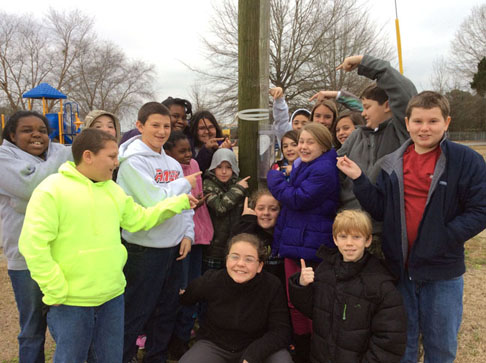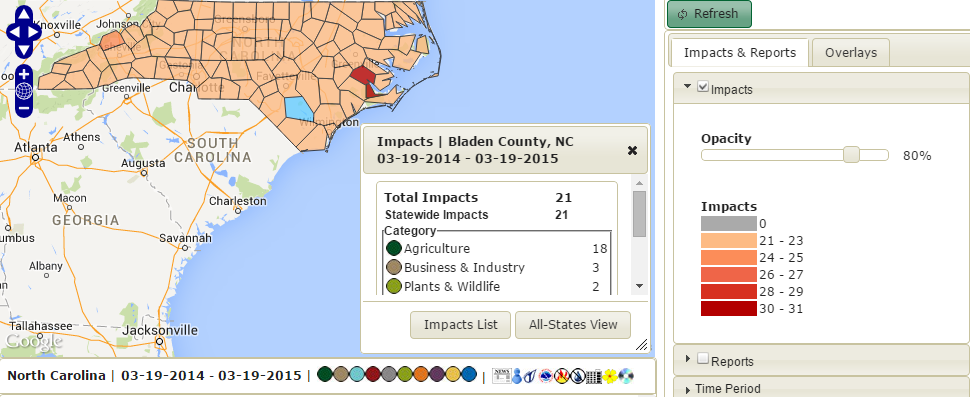We continue our series on CoCoRaHS March Madness with profiles of two observers in North Carolina.
Are you cuckoo for CoCoRaHS?! These two North Carolinians are: Jessica Lowman, a teacher in Lenoir County, and Ed Barrows of Wake County, one of our state’s longest reporting volunteers!
Although before we get to that, you might be curious where the rest of our current CoCoRaHS observers are located. Below is a map showing the number of volunteers per county, which includes folks that have reported at least once since January 1, 2014. While we welcome observers from any county, we would especially love for some new observers to sign up (and make that first report!) in Graham, Swain, Tyrrell, Bertie, and Hertford counties during this year’s March Madness contest.

While we patiently await the latest results to see if North Carolina remains atop the standings, here are two observer spotlights:
Jessica Lowman
Fifth-grade teacher at Southwood Elementary in Kinston, NC
How do your students participate?
We have partners that trade off every day. They go out, take the reading together, dump the water, and then record their findings on their iPads. We do this every morning. They also love when their turn falls on a Monday because they get to do a multi-day recording.
Do you use CoCoRaHS data in your lesson plans?
I incorporate the CoCoRaHS rain gauge into many subjects and topics throughout the year. When we learn about place values and decimals, we talk about the readings on the rain gauge and how we can read it using hundredths of an inch and tenths of an inch. Students understand how to better read the rain gauge and why the numbers are written like they are. During fifth-grade, we also talk a lot about weather during the first 9 weeks. This is why we start the rain gauge off on the first day! We discuss what the weather might be like during the next few days and take predictions on what we think the reading from the rain gauge might be during those next days. It is a fun and exciting tool to use every day and throughout the entire year.

Ed Barrows
CoCoRaHS observer for eight years, from Wake County
How do you participate in CoCoRaHS?
The rain gauge does all the work. I just step outdoors to read the gauge. The phone app makes it easy to enter the data so there is no strain involved (some serious praise should go to the team that keeps that site up and running so well — it’s like Amazon!).
What sparked your interest in CoCoRaHS?
I think the whole CoCoRaHS program is kinda fun, a little bit different and an interesting way to start the day. The website gives me displays of the data so I can compare what is happening at my home with the measurements made by others in the surrounding area. The variability in the numbers reported is quite surprising to someone used to the slick weather graphics we get on TV. It shows me these ground-truth data can be useful. The fact that others may use my data for more than idle chit-chat is kind of mind boggling and an extra bonus for me.
Can you talk about your experience with submitting drought impact and condition monitoring reports?
I do enjoy completing the weekly drought impact reports. It helps keep me a bit more aware of what is going on nature-wise. I report drought data at two locations: at my home and at our place in the NC mountains whenever we are up there. I’d like to do rain reporting at the mountain cabin but our lot is tree covered (and steep) so I don’t have a convenient open place to put the gauge. I should add the staff at CoCoRaHS was able to add the second site to my account; it shows up as a drop-down and it’s an easy selection for no matter what site I’m reporting. Same is true for looking at my data. They rock.

What motivates you to get up and make that observation every morning?
I’ve always enjoyed science and the “citizen science” aspect really appeals to me. I participate in several other citizen science projects and enjoy them all. I can play at science (and not have to sweat the math) and at the end of the day, I can feel maybe I contributed (a very small) something to our understanding of our world. I’d get up a little earlier each day to leave something like that for our kids.
What is unique about participating in CoCoRaHS?
Most people know if it rained yesterday, some may have an idea of light or heavy rain or a reading down to a tenth of an inch, but I know how much down to 1/100th of an inch. Pretty good feeling just having the information.
What is the most interesting or most challenging observation that you’ve taken?
This kind of project doesn’t have much drama or challenge — perhaps if I lived in Alaska I could report on a bear encounter when going out to read the gauge, but here in North Carolina, the most wildlife I’ve seen are the occasional deer in the yard, squirrels and birds at the bird feeders, ducks on the pond and so forth. Nevertheless, it is good to step outside every morning, breathe the fresh air, feel the sunshine, and take my reading.
Reminders
Be sure to check the weekly CoCoRaHS March Madness standings and don’t forget to sign up to be a volunteer!